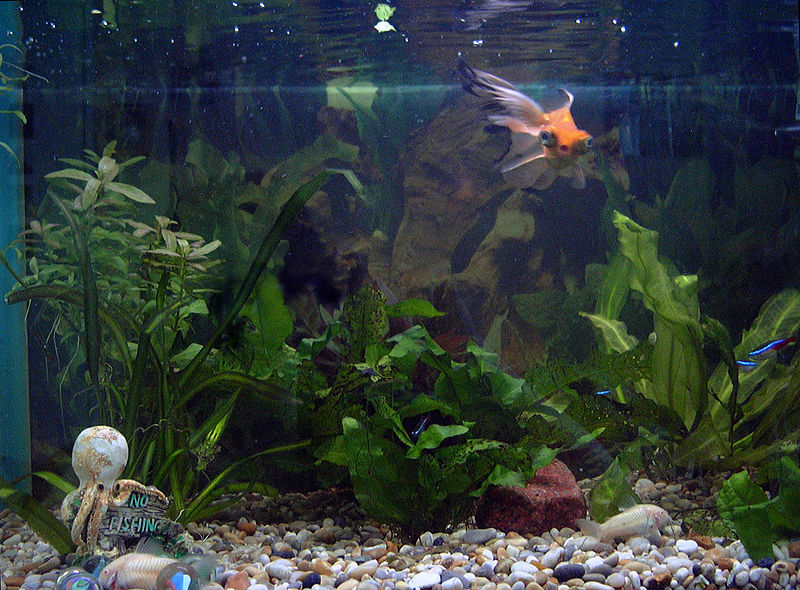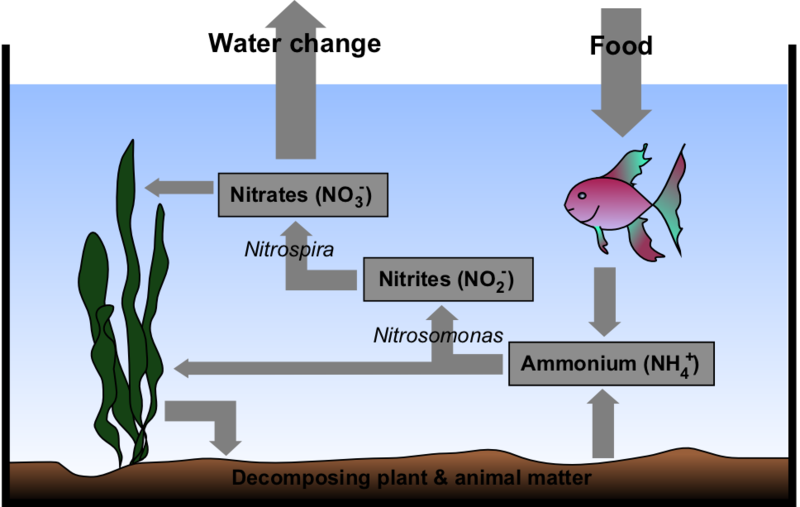 One of the most common questions we receive is about moving an aquarium, whether it is across the room or across the country. Larger tanks and larger fish are certainly more difficult than smaller ones and the larger the distance you are traveling, the more involved the process becomes (although I have used some of these methods when moving my saltwater tank from one room to another when the room it was in was being re-carpeted). For long distances, try checking with your local fish store. Some may be able to help you arrange to have your livestock packed up and shipped via Fedex Overnight or another service. If you are doing the move on your own, there are several tricks and techniques you can use to make things easier on you and your livestock.
One of the most common questions we receive is about moving an aquarium, whether it is across the room or across the country. Larger tanks and larger fish are certainly more difficult than smaller ones and the larger the distance you are traveling, the more involved the process becomes (although I have used some of these methods when moving my saltwater tank from one room to another when the room it was in was being re-carpeted). For long distances, try checking with your local fish store. Some may be able to help you arrange to have your livestock packed up and shipped via Fedex Overnight or another service. If you are doing the move on your own, there are several tricks and techniques you can use to make things easier on you and your livestock.
The Preparation
Once your moving date is set, start assembling your supplies. I recommend that you start doing this at least 3 weeks ahead of time if this is your first move. You’ll need containers to hold your fish, your substrate and filter media, and any water you are taking with you. For the fish, you can use large plastic containers like Rubbermaid tubs or coolers. Styrofoam containers can also be used as long as they are strong enough to support the weight; try taping around the sides and bottom with packing tape or Duct Tape to reinforce it. Avoid using any containers that have held chemicals in the past since chemicals can leech into the plastic, and may poison your livestock. You can also line the containers with thick plastic bags – I would recommend thick black Contractor’s bags that can be found at hardware and home improvement store.
For the substrate and filter media, a similar container will work. Keep in mind that substrate is heavy and still needs to stay wet and aerated to prevent the bacteria on it from dying. Same thing with the filter media (although it usually isn’t as heavy as, say, gravel or aragonite). Larger-grained substrate that has been cleaned regularly is usually safe to transport and still use in your aquarium, but keep in mind that substrates that have not been stirred up or clean regularly or very fine particles can contain anoxic bacteria or organic matter that can be toxic if released into the water. If in doubt, or if you aren’t able to safely transport the entire volume of substrate, only save a small amount from the top layer to help re-establish the beneficial bacteria populations once you set the aquarium up in its new home. You can also add extra biological filter media (Bio-Wheels, filter bags with ceramic rings or bio-balls, sponge filters, etc) to the aquarium several weeks before the move to allow it to become colonized with bacteria to transport to the new aquarium.
Saving as much of the water as possible can help when setting your tank up at its new location as well, especially for saltwater systems. Keep in mind that, although it doesn’t hold as much as surfaces like the substrate, filter media and even ornaments and decorations, there is still living bacteria and organisms in the water. Completely sealing off the containers can deplete the oxygen and suffocate anything living in it. Live rock, plants, and ornaments need to stay wet but don’t necessarily need to be submerged; you can usually wrap them in wet newspaper and seal them in plastic bags or containers. I don’t recommend keeping them in the same containers you are using to transport the livestock since they can shift around and may injure your fish.
This is also the time to research the aquarium’s new location. What is the water chemistry like where the new aquarium is being set up? Is it well water or municipal water? Are there any differences in hardness or alkalinity or other parameters from the water you’ve been used to using? Where will the tank be set up – can the floor structurally support the weight of the aquarium in its new location? This is your time to prepare and avoid any surprises when it comes time to set up the new aquarium.
The Move
On “moving day”, start by removing any decorations, plants, rockwork and other objects from the aquarium. This is will make it easier – and safer – to catch your fish and inverts. Next, prepare the containers for the livestock. If you are using large containers (tubs, styro’s, coolers), make sure they are not too heavy to lift once filled with water. If you are bagging your fish, make sure they have enough air to last the trip. The bags should be about half to two-thirds air and half to one-third water. Either used compressed oxygen to fill the bag or quickly grab and close the top; avoid blowing into the bag since the air we exhale will be higher in carbon dioxide and lower in oxygen. It is a good idea to at least double-bag the livestock in case one bag gets punctured. Once all the livestock is in its containers and ready to ship, you can save any water and substrate you are taking to the new location and pack it away as well before draining and emptying the aquarium.
Only move the tank when it is completely empty; avoid leaving any water or substrate in the tank while it is being moved. They aren’t designed to be moved with the weight in them or support that weight without being braced on the bottom and leaving substrate, water, or ornaments in the tank increases the chance of it cracking or sealed becoming broken. Enlist the help of several people to move larger tanks and keep it as flat as possible while moving. When packing the empty tank into the vehicle being used to transport it, use bubblewrap or blankets to cushion it during the move.
The Set-up
 Once you get the aquarium to its new home, its time to start setting things back up. Depending on your time frame, this may be the first thing you do or you may be able to wait until the next day if you packed things appropriately. Keep in mind that even though you may have own the tank and things in it for years, this is now a “new” aquarium. It will need to be re-established and will likely go through the infamous Cycling Process again (cloudy water, diatomaceous algae blooms, ammonia and nitrite spikes, etc.).
Once you get the aquarium to its new home, its time to start setting things back up. Depending on your time frame, this may be the first thing you do or you may be able to wait until the next day if you packed things appropriately. Keep in mind that even though you may have own the tank and things in it for years, this is now a “new” aquarium. It will need to be re-established and will likely go through the infamous Cycling Process again (cloudy water, diatomaceous algae blooms, ammonia and nitrite spikes, etc.).
Moving an aquarium is certainly more involved than packing up the rest of your belongings and takes some planning and foresight – after all, tangs don’t take kindly to be wrapped in bubblewrap – but with some care and preparation, you can have your aquarium back to normal soon! If you’re planning a move and you have any other questions, please let us know! We’ll be happy to help if we can!
Thanks,
Eileen
 That Fish Blog – Aquarium Advice and Information
That Fish Blog – Aquarium Advice and Information

Im moving now my 100 gallon fish tank from home to my office I really needed some practical advice thanks
Michael
Thanks, Michael, hope the move was successful.
I have had to do this with my tanks and helping friends move their tanks as well (i guess that is the price i pay for owning a pickup) this article really explains it all and the only other advice i have is to just take your time and be careful it is important to get the move done as fast as possible to stop the fish from getting overly stressed, but don’t rush to the point you start getting reckless. it is better to take an extra 20 min to make the move rather than screw up and break something…like the tank
These tips are priceless! Thank you for sharing! Moving home with a big fish tank is a really serious challenge! Greetings!
Thanks Elizabeth, good luck with your move!
Thank you so much for sharing this article! I am going to move to another apartment and I should move my aquarium too and I had no idea how exactly to do that. Thank you again for the nice advices! You helped a lot!
lol i love how you spent most of the article talking about the preparation because that’s true… it really is the most important part
Thanks Bill…I couldn’t agree more. Preparation is key! 🙂
Any help for upgrading to a tank double in size that must go in the exact spot as smaller one? Also going from gravel to sand. Running new filter already and will move the old one to new tank as well. Please help. This all happens in 4 days and I am terrified!
Hi Jane, We have a blog on How To Upgrade Your Aquarium with tips on just that! The same tips that we discussed here still apply.
Driving from MI to CA approx: 34hrs
I have 3 tanks (20g, 35g & 65g) that I’m trying to take with me so any advice greatly appreciated. Current idea is put the 65g in the van 1/2 full run the bubbler and filter through the van since the van has an outlet… biggest problem is I can’t do the 34hrs straight with a little one and wanted to sleep at a hotel…. this is so stressful I’m completely stuck trying to do what’s best…. again any advice is appreciated.
Hi Dominique, I would not have a glass aquarium with water in it in a moving vehicle for any period of time. Any shifts and bumps along the way could easily cause the glass to crack with the weight of the water shifting in it. The easiest thing to do would be to contact a local fish store or even aquarium club to see if someone could help ship your fish for you. We use Fedex overnight shipping at our store to ship to customers all the time. I would see if someone could help you ship them to you, even if they can keep them in some tubs with an aerator for a day and ship them so they arrive shortly after you do, or see if they can be shipped to a local store at your destination. If you absolutely have to take them in the van, get some sturdy Rubbermaid-style containers and see if you can take them into your hotel room overnight if the overnight temperatures at your stop are too extreme to keep them in the van.